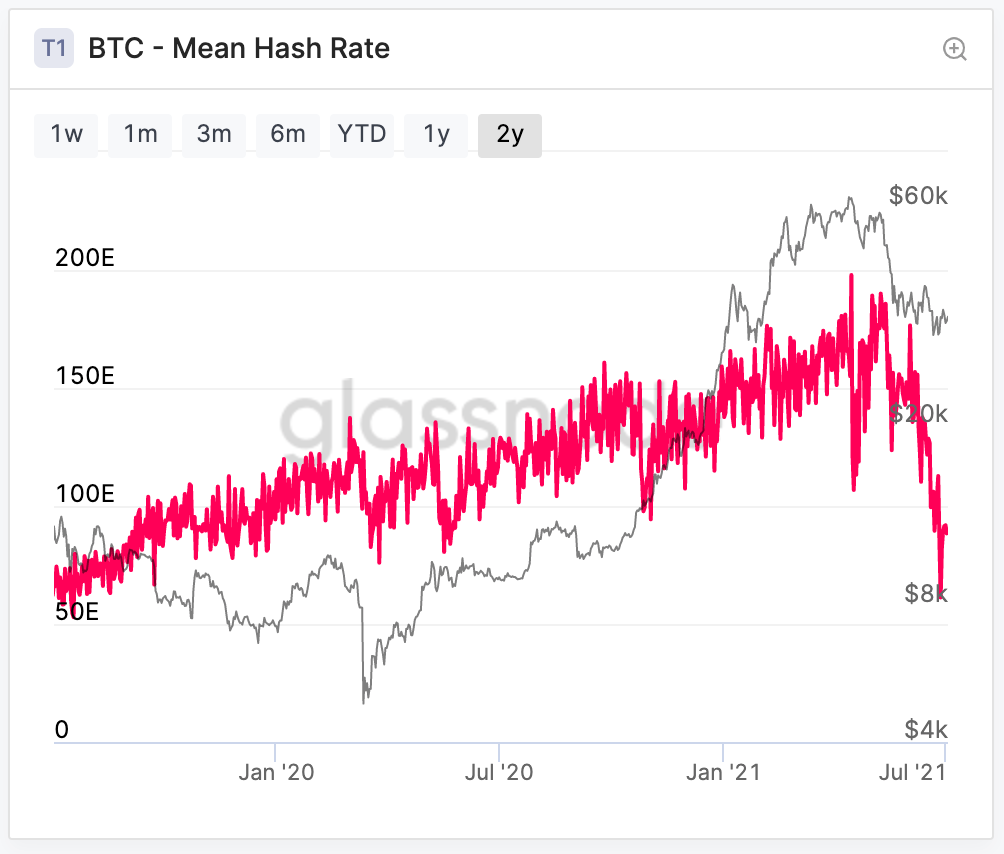What are Bitcoin Miners Doing?
A quick overview of the most important Bitcoin mining stats - On-chain mining stats
Hey DEFI TIMES community,
China effectively banned Bitcoin mining last week - this could be a significant geopolitical mistake!
In addition to mining, China also cracked down on Chinese payment institutions dealing with crypto transactions.
Those payment institutions include:
Alipay
the Agricultural Bank of China
the China Construction Bank
the Postal Savings Bank of China
and the Industrial Bank
Both of the news caused a big FUD wave. Besides the price dump, one of the most significant effects was the impact on Bitcoin mining.
A large percentage of Bitcoin’s hash rate comes from China.
Long story short: miners are rushing to leave China - they are forced to!
As you might have guessed, Bitcoin’s hash rate fell significantly over the past few days - that happens when miners are shutting down or relocate.
But let’s explore some other stuff that’s happening in the mining industry.
Did we suffer significantly from the China news? Or does it still look healthy?
Let’s explore some mining stats today!
Subscribe to our newsletter to level up your crypto game!
What are Bitcoin Miners Doing?
Hash Rate
Let’s start with the most important metric of them all: The Bitcoin Hash Rate. The Hash Rate ultimately gives evidence of how healthy Bitcoin is.
The higher the hash rate, the safer the network because it’s harder to attack Bitcoin. That’s why we want the hash rate to grow. If it shrinks, something must be wrong, and Bitcoiners get worried.
Whenever the has rate goes down significantly, some people start to become worried that a mining death spiral could occur.
The death spiral theory says that miners leave because of sudden mining unprofitability. As a result, the network hash rate decreases. And then the block time increases, meaning that miners are even less profitable. This vicious cycle would then continue until there are no miners left.

Because Bitcoin's hash rate has been going down significantly during the past few weeks, many people are worried if we could see such a death spiral.
In fact, Bitcoin's hash rate is more than 53% down from what it was in early May - that's a lot!
However, there is one reason for this that explains everything: Chinese miners are only temporarily shutting down their mining gear.
They have to relocate and move somewhere else!
The ASIC mining power is not lost. It will come back as soon as Chinese miners have moved out of China.
The first miners have already moved to Kazakhstan. Others will be moving to the US or somewhere else.
A death spiral is very unlikely here.
Balance in Miner Wallets

Another interesting thing to consider is the bitcoin balance in miner wallets. How are miners reacting to the sharp price- and hash rate decline?
People have been speculating that miners contributed to the price decline over the last few weeks. In the end, miners could be selling to cover the costs of relocating from China. As you can see, miners have reduced their bitcoin holdings by slightly over 5,000 since last month. That's not too much and would probably don't have too much of an impact on Bitcoin's price.
That means that miners are currently not selling significant portions of their holdings, which is a positive sign.
Miners are still betting on a price increase! Holding Bitcoin is risky for miners as they have recurring electricity costs to cover. Whenever they take the risk of not selling, they effectively take a long position.
Mining Difficulty
The mining difficulty tracks how difficult it is to mine Bitcoin. It's directly correlated to the hash rate; every two weeks, the mining difficulty adjusts to the total computing power. That means when the hash rate goes down, the difficulty declines too. On the other hand, when the hash rate goes up, it becomes more and more challenging to create the next block.
While a low mining difficulty is a good sign for miners, it's not positive for the network's health - the lower the difficulty, the easier it is to attack Bitcoin.
As you can see, the mining difficulty has greatly fallen since the drop of Bitcoin's hash rate.

While that means that Bitcoin has become more prone to attackers, it also prevents a death spiral.
Even though the hash rate fell, it has become easier to mine Bitcoin. That means that the network has already adjusted to the hash rate drop.
Conclusion
Even though Chinese miners had to shut down their operations, mining on-chain stats look pretty healthy.
There is no danger for a mining death spiral to happen… the difficulty has already adjusted!
Miners are not selling and, rest assured, Chinese computing power will come back! Sooner or later!
Find us on:
DISCLAIMER: All information presented above is meant for informational purposes only and should not be treated as financial, legal, or tax advice. This article's content solely reflects the opinion of the writer, who is not a financial advisor.
Do your own research before you purchase cryptocurrencies. Any cryptocurrency can go down in value. Holding cryptocurrencies is risky.


